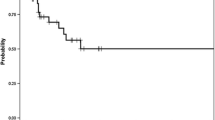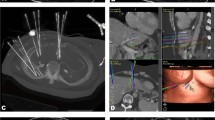Purpose:
To compare local tumor control after percutaneous tumor ablation by interstitial laser therapy (ILT) or CT-guided brachytherapy (CTGB).
Patients and Methods:
In a matched pair analysis including 18 patients with 36 liver metastases of colorectal primary, both ILT and CTGB were performed in different lesions. The following matching factors were considered: (i) tumor size ≤ 5 cm, and (ii) execution of chemotherapy after tumor ablation. Primary endpoint was local tumor control.
Results:
Treated lesions were identical in terms of tumor size and all matching criteria were fulfilled in all patients except for the performance of adjuvant chemotherapy. Median follow-up was 14 months (3–24 months) for both groups. Only five of 18 patients (28%) demonstrated local tumor progression after CTGB, whereas in ten of 18 patients (56%) tumor progression was found after ILT. Differences encountered were significant for all patients (p = 0.04), whereas in those who fulfilled all matching criteria (n = 14) the level of statistical significance was not reached (p = 0.23).
Conclusion:
CTGB demonstrated superior local tumor control compared to ILT in long-term follow-up.
Ziel:
Intraindividueller Vergleich lokaler Kontrollraten nach perkutaner Tumorablation mit interstitieller Lasertherapie (ILT) oder CT-gestützter Brachytherapie (CTGB) von intrahepatischen Metastasen bei kolorektalem Karzinom.
Patienten und Methodik:
Eine Matched-Pair-Analyse wurde bei 18 Patienten mit insgesamt 36 Lebermetastasen eines kolorektalen Karzinoms durchgeführt. Je eine Metastase wurde mit perkutaner Tumorablation mit ILT und je eine mit CTGB behandelt. Bei den Patienten mit identischer Tumorhistologie wurden folgende Faktoren betrachtet: 1. Tumorgröße ≤ 5 cm und 2. Durchführung oder Verzicht auf eine adjuvante Chemotherapie. Als primärer Endpunkt wurde die lokale Tumorkontrolle definiert.
Ergebnisse:
Die Verteilung der Tumorgrößen war gleich, und alle Patienten erreichten volle Übereinstimmung bis auf den Vergleichsfaktor der adjuvanten Chemotherapie. Die mediane Beobachtungszeit betrug 14 Monate (3–24 Monate) für beide Gruppen. Fünf von 18 Patienten (28%) hatten eine lokale Tumorprogression nach CTGB und zehn von 18 Patienten (56%) nach ILT. Die Differenz zwischen den Gruppen war für alle Patienten signifikant (p = 0,04). Bei der Betrachtung der Patienten mit völliger Übereinstimmung wurde die Signifikanzgrenze nicht erreicht (p = 0,23).
Schlussfolgerung:
Die CTGB zeigt in der Langzeitbeobachtung überlegene lokale Tumorkontrollraten im Vergleich zur ILT.
Similar content being viewed by others
Author information
Authors and Affiliations
Corresponding author
Rights and permissions
About this article
Cite this article
Pech, M., Wieners, G., Kryza, R. et al. CT-Guided Brachytherapy (CTGB) versus Interstitial Laser Ablation (ILT) of Colorectal Liver Metastases. Strahlenther Onkol 184, 302–306 (2008). https://doi.org/10.1007/s00066-008-1815-5
Received:
Accepted:
Issue Date:
DOI: https://doi.org/10.1007/s00066-008-1815-5




